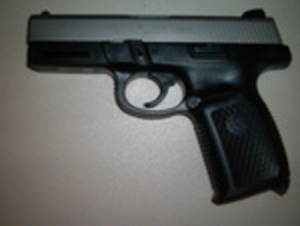If there is one topic that firearms enthusiasts love to debate, it’s which handgun caliber is best for self defense. Should you choose 9 mm, .40 caliber, or .45 caliber for your defensive pistol? Is a .45 better than 9mm? Is .40 caliber the best compromise between 9mm and .45 caliber. Each caliber has its advocates. They make their points vociferously on the internet in online forums.
There are several factors to weigh in choosing a defensive handgun caliber: stopping power, target penetration, recoil, availability, and cost. Stopping power is the ability of a round to stop an attacker. Target penetration has to do with the idea that a bullet could pass through a target a cause unintended harm beyond the target. Recoil is a consideration for shooting comfort, firearm control, and the ability to fire rapid follow up shots.
When it comes to stopping power, the .45 ACP is the king. It was developed as a result of U.S. combat experience against guerillas in the Phillipines. But, examining the Stopping Power Chart for a similar load for 9mm, .40 S&W;, and .45 ACP, yeilded some surprising results. The Federal .45 ACP jacketed hollow point (JHP) round weighs 230 grains, leaves the muzzle at 1001 feet per second (fps), and has 411 foot-pounds of muzzle energy. The 9mm is the most widely used military handgun round in the world. A Federal 9mm round weighs in at 115 grains, has a muzzle velocity of 1175 fps, and has 341 foot-pounds of muzzle energy. In between, the Remington .40 caliber S&W; round weighs in at 155 grains, leaves the muzzle at 1140 fps, and hits with 447 foot-pounds of energy. In this comparison, the .40 caliber S&W; round has a slight edge in muzzle energy. It might be time to crown a new king.
What does this mean in the real world? In their book, Handgun Stopping Power, gun writers Evan Marshall and Edwin Sanow have culled through police reports of thousands of police and personal defense shootings and determined how many times a particular handgun round stopped a suspect with one shot. For defensive shooters, all three of these calibers have a high rate of one shot stops against people. The Federal 9mm JHP is estimated to stop people 81% of the time with one shot. The Remington .40 S&W; JHP is estimated to stop people 86% of the time. Finally, the Federal .45ACP JHP is estimated to stop people 87% of the time. In terms of one shot stops, the vaunted .45 ACP round has a slight edge over the .40 caliber and both have a significant advantage over 9 millimeter.
Each of these rounds can penetrate many inches of ballistic gelatin. The Federal 9mm JHP can penetrate 14.5-inches of ballistic gelatin. The Federal .45 ACP JHP can penetrate 13.6-inches of ballistic gelatin. A Federal .40 S&W; Federal hydrashock penetrates 13.3-inches of the gelatin. Gun writers typically advise 9mm shooters to use jacketed hollowpoints so that they will break up on impact with an intruder or wallboard and not pass through to harm people beyond the target. That’s probably good advice for any shooter.
Outside of the math of bullet energy and penetration, there are additional real world considerations. In the store, 9 millimeter ammunition is significantly cheaper than either .40 S&W; or .45 ACP. The 9 millimeter has the lightest recoil, followed by the .40 S&W;, and then .45 ACP. Generally women or people with slighter builds prefer to shoot 9mm rather than the heavier recoiling .45 ACP. People who are comfortable with the firearm they shoot are more likely to practice and hit their targets. While some determined attackers under the influence of serious narcotics might press on with an attack after being shot, most attackers will either be incapacitated or break off an attack and attempt to escape after being shot.
In terms of objective science, the .45 ACP is probably the best, most proven, defensive handgun round available. But, I still chose the Smith & Wesson 9mm SW9VE Enhanced SIgma Semiautomatic pistol for home defense. It fit my budget and was comfortable for me to shoot. In the real world, it is more important for the defensive shooter to find a firearm they are comfortable shooting, can afford to shoot, and that can be effective in shooting. Then, they have to find a brand of ammunition that works well in their chosen firearm and that does not over-penetrate targets.
Sources:
Handgun Stopping Power Chart, Chuck Hawks, Chuckhawks.com
Stoppingpower.net
Personal Experience
Other articles by this contributor:
Handgun Review: Old Model Ruger Vaquero Revolver in .45 Colt
Three Innovative Revolvers for 21st Century Shooters
Rifle Review: Henry Repeating Arms .22 Caliber Lever-Action Rifle
